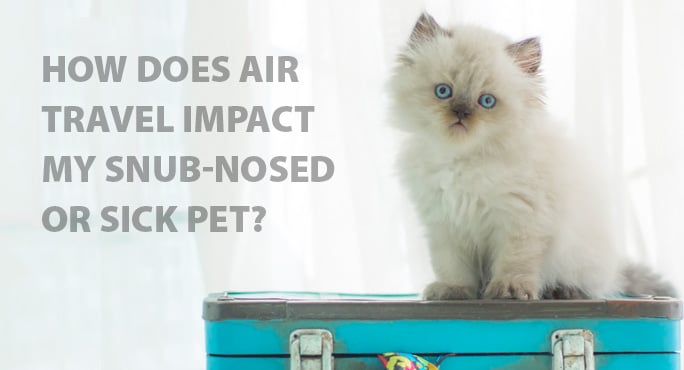How Does Air Travel Impact My Snub-Nosed or Sick Pet?
Published on: August 14, 2019 | Author: Starwood Pet Travel

As a pet parent, your Number One priority is your pet’s safety. Hundreds of thousands of animals of every description fly to and from locations around the world every year, yet mishaps are few. Nonetheless, for some family pets there are special factors you should consider before you decide if air travel is right your dog or cat.
These considerations relate to age, overall health, and (you may be surprised by this one) breed.
While pet-friendly airlines take care to ensure pets traveling as cargo ride in the same temperature-controlled and pressurized environment that you do in the passenger cabin, an international journey often requires multiple and/or long flights, even layovers. And although you may never set foot outdoors from the time you enter the airport to depart until you exit the airport in your few foreign city, traveling pets are often exposed to the elements as they are conveyed to and from the plane for each leg of their trip.
For most healthy pets, these issues are not fun, but they are also not a threat to health, comfort or safety. For special needs dogs and cats, however, these issues can pose very serious problems. Here is what you need to know:
1. Everything is a little harder for elderly pets
Just like people, pets slow down as they age. Many don’t handle change as well as they used to, emotionally and/or physically. So the rigors and inherent stress of air travel may be more than they can handle.
2. Chronic illness can interfere with air travel
If your pet suffers from diabetes, a heart or liver condition, or some other type of chronic illness, you may not think of him as “sick,” but his compromised health could put him at higher risk for problems during air travel. (This is also true if your pet is overweight.) Does he take medication such as insulin that must be administered on a strict schedule? That could make it difficult (or impossible) to arrange a suitable flight itinerary.
3. Snub-nosed pets are a specific concern
Brachycephalic dogs, cats, and rabbits – those with shortened or flat snouts – have difficulty breathing because their air passages and the rest of their nasal anatomy are naturally constricted. Snub-nosed breeds often suffer from other chronic conditions including neurological, eye, heart, and gastrointestinal defects or disease. Stress, heat, cold, and other factors can all exacerbate these problems, making “brachys” poor candidates to fly.
Most airlines now have at least some restrictions on snub-nosed breeds, and some carriers won’t accept them at all. Many do not differentiate between purebred animals and those who are cross-breeds, including all of them in their restrictions. Even airlines that do allow snub-nosed pets typically embargo them during the summer (May-September). Higher temperatures intensify breathing problems and stress, making summer the most dangerous time to travel.
What should you do?
- Talk to your vet. Every pet is different, so it is essential to consult your pet’s veterinarian to get their medical opinion on your dog or cat’s fitness to fly. They know his personality as well as his health.
- Talk to your airline. However, every air carrier has rules about what pets are eligible to fly, when and where. Ask specifically how your airline’s rules will affect your elderly, ill, or snub-nosed pet.
If you have further questions about your special needs pet and air travel, our Starwood Animal Transport experts are here to help you.
Starwood Animal Transport has rebranded to Starwood Pet Travel. We are still the same great company with the best team, just now with a slightly different name.
Subscribe to the Blog
Enjoy our content? Get them sent to your inbox!
Subscribe Now!


